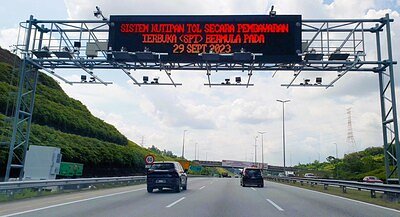
Malaysia's Smart Toll Revolution: FETC Leads the Way to Congestion-Free Roads
A successful pilot program is paving the way for a nationwide shift to automated tolling in Malaysia, promising reduced congestion, lower emissions, and a blueprint for smart cities across Southeast Asia.
Malaysia's Smart Toll Revolution: FETC Leads the Way to Congestion-Free Roads
Kuala Lumpur, Malaysia – A groundbreaking pilot program on the Maju Expressway is demonstrating the potential of Multi-Lane Free Flow (MLFF) technology to revolutionize tolling in Malaysia and across Southeast Asia. Singapore-based Intelligent Transportation Systems (ITS) provider, FETC International, has achieved 100% accuracy in vehicle detection and toll collection during the trial, paving the way for a nationwide rollout and positioning Malaysia as a leader in smart city infrastructure.
For decades, Malaysian highways have been characterized by toll booths – a source of congestion, delays, and operational costs. But a paradigm shift is underway. The Maju Expressway pilot, utilizing FETC’s proprietary AI-powered system, eliminates the need for physical barriers, allowing vehicles to pass through seamlessly while automated systems accurately identify and charge tolls.
"The results from the Maju Expressway are truly remarkable," said a source close to the project. “We’re seeing a significant reduction in congestion, a boost in revenue, and a dramatically improved driver experience. This isn't just about automating tolling; it’s about creating a more efficient and sustainable transportation ecosystem.”
Beyond the Booth: How MLFF Works
FETC’s MLFF system utilizes a combination of advanced technologies, including high-resolution cameras, radar sensors, and sophisticated AI algorithms. These components work in harmony to identify vehicles, classify them based on vehicle type, and accurately calculate toll charges. The system also integrates with mobile payment platforms, allowing drivers to pay tolls effortlessly via their smartphones.
“The key differentiator with FETC's approach is their AI,” explained a transportation analyst. “They’ve developed algorithms that can handle challenging conditions like low light, heavy traffic, and adverse weather, which are common in this region. This level of accuracy is crucial for ensuring a reliable and seamless experience for drivers.”
A Regional Shift Towards Automated Tolling
Malaysia’s commitment to MLFF aligns with a broader trend towards automated tolling across Southeast Asia. Singapore is already well advanced in its MLFF deployment, with plans to cover all expressways by 2026. Indonesia, Thailand, and the Philippines are also actively exploring and piloting MLFF solutions.
“There’s a growing recognition across ASEAN that smart tolling is essential for addressing congestion, improving air quality, and promoting economic growth,” stated a government official involved in the region’s smart city initiatives. “FETC's success in Malaysia is serving as a model for other countries looking to embrace this technology.”
Economic and Environmental Benefits
The shift to MLFF promises a range of economic and environmental benefits. By eliminating toll booths, governments can reduce operational costs, increase revenue, and improve traffic flow. The reduction in idling and stop-and-go traffic also translates into lower emissions and improved air quality.
According to data from the Maju Expressway pilot, the MLFF system has resulted in:
- 40% reduction in operational costs (due to elimination of toll booth staff)
- 12% increase in revenue (due to reduced toll evasion)
- 18% decrease in vehicle emissions (due to smoother traffic flow)
Addressing the Challenges
While the potential benefits of MLFF are significant, there are also challenges to overcome. Data privacy concerns, cybersecurity threats, and the need for interoperability across different transportation networks are all critical considerations.
“Protecting driver data and ensuring the security of the tolling system are paramount,” stated a cybersecurity expert. “Robust encryption, access controls, and regular security audits are essential to mitigate these risks.”
Interoperability is another key challenge. For MLFF to be truly effective, it needs to be compatible with transportation networks across different countries and regions. “Establishing common standards and protocols is crucial for enabling seamless travel across borders,” stated a regional transportation official.
FETC’s Expanding Footprint and Future Prospects
FETC International has emerged as a leading provider of MLFF solutions in Southeast Asia. The company’s success is driven by its innovative technology, strong partnerships with government agencies, and commitment to sustainability. FETC currently holds a 24% share of the Asia-Pacific MLFF market, surpassing competitors like Cubic and Kapsch.
With several new MLFF projects in the pipeline across the region, FETC is poised for continued growth. The company is also exploring opportunities to integrate its technology with other smart city applications, such as traffic management systems and public transportation networks.
“This is more than just about tolling; it's about building a more connected and sustainable transportation ecosystem,” stated a source familiar with FETC’s strategic direction. “We envision a future where transportation is seamless, efficient, and environmentally friendly.”
As Malaysia prepares to roll out MLFF nationwide, it is setting a powerful example for the rest of Southeast Asia. The successful pilot on the Maju Expressway demonstrates that a congestion-free, sustainable future is within reach—and that technology can play a pivotal role in achieving it. With continued investment, collaboration, and a commitment to innovation, the region can unlock the full potential of smart tolling and create a transportation system that is fit for the 21st century.
